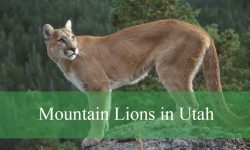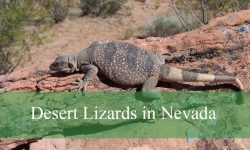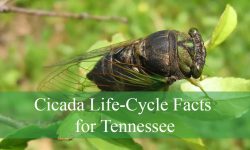Across Indiana, a mix of sunny grasslands, rocky slopes, forest edges, and sheltered clearings provides the warmth and cover that several native lizard species need to survive, even though the state is not widely known for reptile diversity. From fast-moving racerunners to secretive skinks and rare legless lizards, each species brings unique behaviors, habitats, and adaptations to the landscape. Some are easy to spot along forest floors or sunny fence lines, while others stay hidden deep in leaf litter or grassy cover.
Because several of these lizards are quick, elusive, and excellent at camouflage, many people in Indiana rarely realize how many species live around them. Some are widespread and adaptable, while others persist only in small, isolated habitats that offer the specific conditions they require. Their presence often indicates healthy ecosystems rich in insects, moisture, and natural shelter.
This guide introduces 8 types of lizards in Indiana, offering clear identification details, behavior insights, and habitat information to help you recognize each species with confidence. Exploring the state’s trails, forests, and open habitats becomes more rewarding once these remarkable reptiles become easier to identify and appreciate.
Common Types of Lizards Found in Indiana
Eastern Fence Lizard
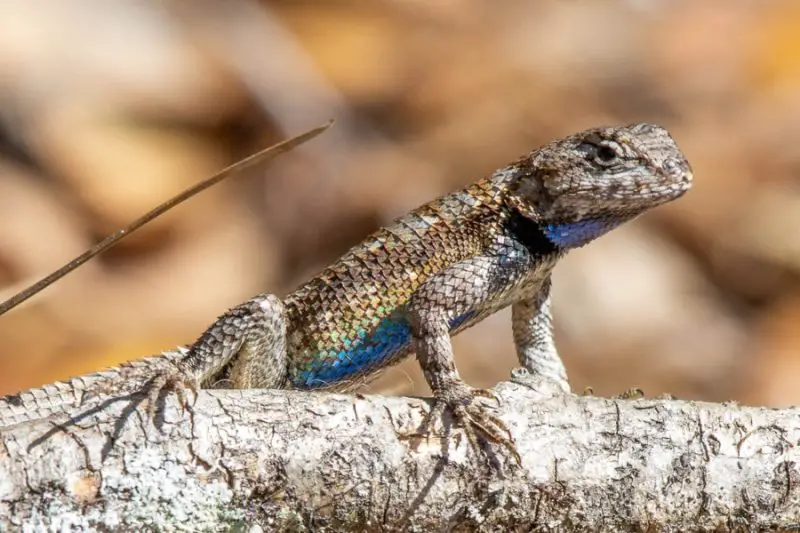
The Eastern Fence Lizard is a familiar reptile in Indiana, recognized by its rough, keeled scales and earthy coloration ranging from gray to brown. Adults typically measure 10 to 18 centimeters, with males displaying bright blue patches on their throats and bellies during the breeding season. Their triangular heads and spiny appearance make them easy to identify among the state’s native lizards.
These lizards prefer dry, open habitats such as woodlands, sandy ridges, rail fences, and rocky outcrops. They spend a large part of the day basking in sunny spots, using their excellent vision to watch for movement. When threatened, they dart quickly to tree trunks or loose bark, blending almost perfectly with the surface.
Eastern Fence Lizards primarily feed on insects like beetles, ants, spiders, and small caterpillars. Their hunting style is active but patient, involving quick sprints to snatch prey. Their diet helps maintain balance in woodland ecosystems by reducing insect populations.
In Indiana, these lizards are most common in the southern and central regions where dry, wooded environments are widespread. Their adaptability allows them to survive near human structures as well, especially in rural areas with abundant fence lines and sunlit clearings.
Six-Lined Racerunner
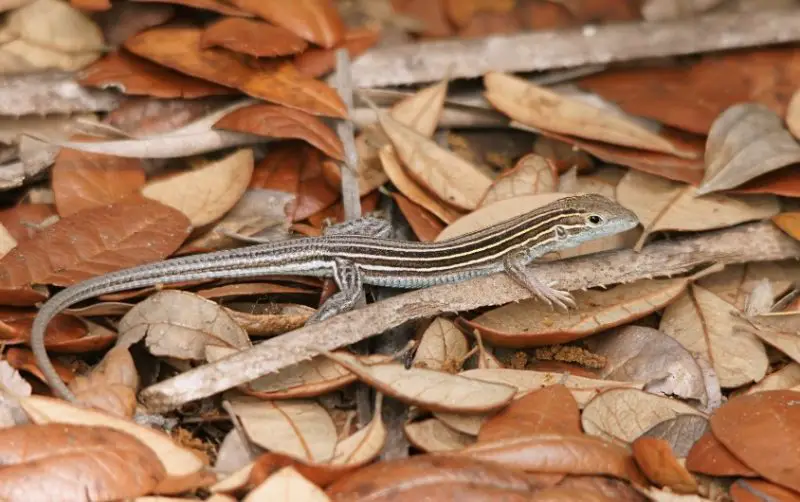
The Six-Lined Racerunner is one of the fastest lizards in Indiana, instantly recognized by the six bright yellow or greenish stripes running along its dark body. Adults usually measure 15 to 25 centimeters, with long tails that can double their body length. Their slender shape and constant alertness make them appear in near-constant motion.
These lizards thrive in open, sunny habitats such as prairies, sandy hills, field edges, and sparse woodlands. They require warm temperatures and loose, dry soil to support their fast-paced lifestyle. When startled, they sprint at impressive speeds, often vanishing into grass or hiding beneath debris.
Six-Lined Racerunners are active hunters that consume ants, grasshoppers, spiders, and small beetles. Their keen eyesight and quick reflexes allow them to chase down prey rather than wait for it. They are most active during the hottest parts of the day, unlike many other reptiles that avoid intense heat.
In Indiana, they are primarily found in the southern half of the state, where open habitats provide the warmth they need. Their populations are patchy but stable, often forming strongholds in areas with sandy soils or restored prairie landscapes.
Common Five-Lined Skink
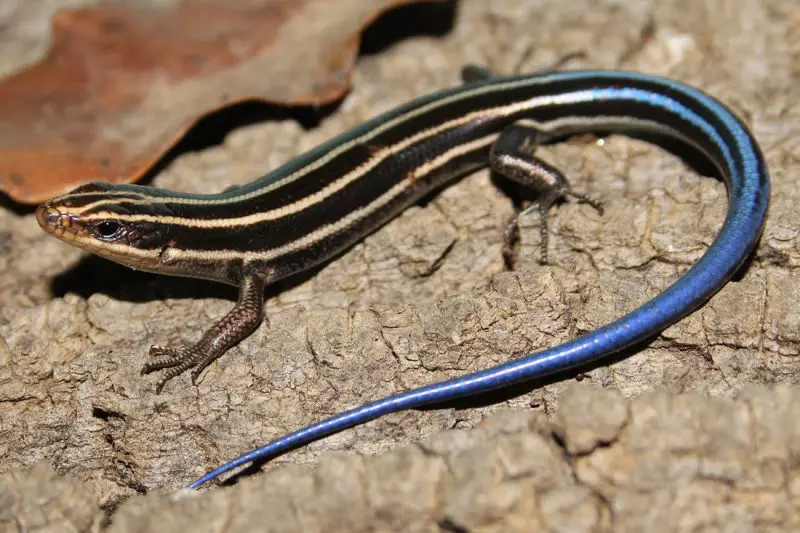
The Common Five-Lined Skink is one of Indiana’s most recognizable lizards, known for its glossy scales and five bold stripes running from head to tail. Juveniles feature a bright blue tail that fades with age, while adults turn darker with tan or brown striping. These skinks typically measure 12 to 21 centimeters, with smooth, sleek bodies that allow them to slip through leaf litter with ease.
They prefer moist, wooded habitats such as forests, fallen logs, rotting stumps, and shaded rock piles. Five-Lined Skinks spend much of their time hiding under debris to regulate their temperature and avoid predators. They are agile climbers but more often seen scurrying across logs or leaf-covered forest floors.
Their diet consists mainly of insects, including crickets, beetles, spiders, and small invertebrates. They hunt by ambush or quick bursts of movement, relying on their speed to catch prey. Juveniles may use their blue tails as a distraction to confuse predators, a useful tactic in dense forest environments.
In Indiana, the Common Five-Lined Skink is widespread and found in nearly every county with suitable woodland habitat. Their adaptability allows them to live comfortably in suburban areas as well, particularly around gardens, woodpiles, and shaded stone walls.
Broad-Headed Skink
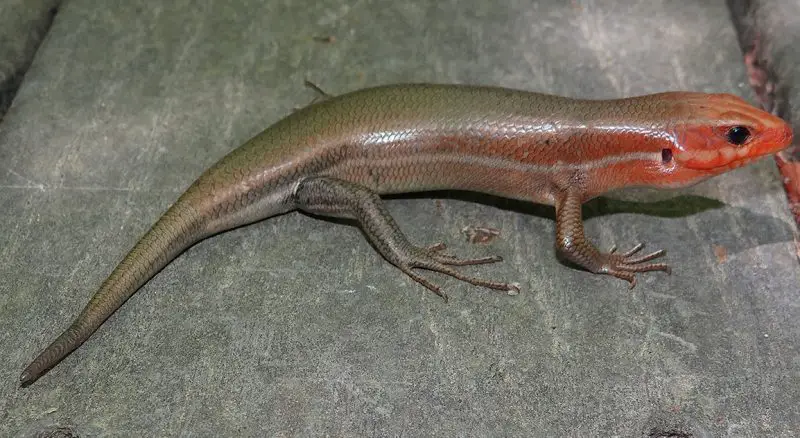
The Broad-Headed Skink is the largest skink species in Indiana, reaching lengths of 15 to 33 centimeters. Males develop oversized, orange-red heads during the breeding season, giving them a powerful and distinctive appearance. Females and juveniles resemble Five-Lined Skinks with striped bodies, though adults gradually lose their stripes as they mature.
This species favors mature forests, especially areas with abundant leaf litter, logs, and high tree canopies. They are excellent climbers and spend significant time in trees, often hiding under loose bark or sunning themselves on fallen logs. Despite their size, they are elusive and more often heard rustling than seen.
Broad-Headed Skinks feed on a variety of insects, including beetles, roaches, caterpillars, and spiders. Their strong jaws allow them to tackle larger prey items compared to other skinks. They hunt both on the ground and in trees, taking advantage of their climbing ability to reach insects in higher branches.
In Indiana, they are mainly found in the southern parts of the state where warm, forested environments are plentiful. Their dependence on mature woodlands makes them less common than other skinks, but they remain well-established in undisturbed habitats with plenty of tree cover.
Little Brown Skink (Ground Skink)
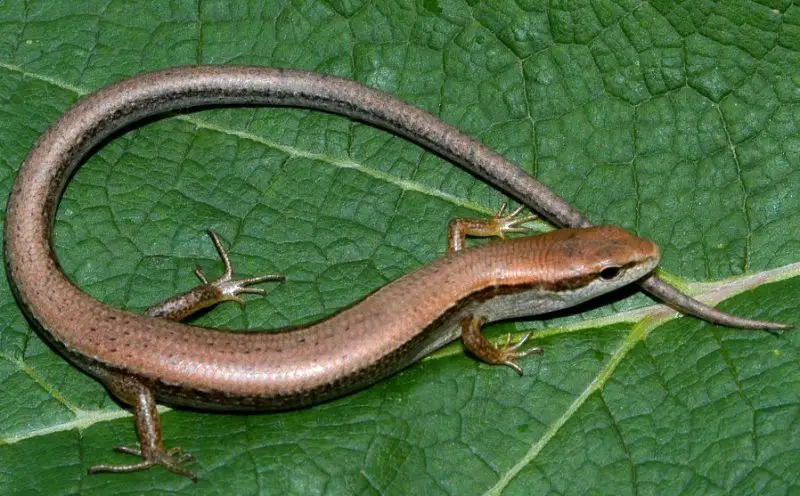
The Little Brown Skink, often called the Ground Skink, is the smallest lizard species in Indiana, typically measuring just 7 to 14 centimeters from nose to tail. Its smooth, copper-brown body and long, delicate tail help it blend easily with soil and leaf litter. The dark stripe running along each side of its body provides simple but reliable identification.
This species prefers moist forests, wooded slopes, and areas thick with fallen leaves. Unlike many lizards that climb or bask on logs, the Ground Skink spends almost all its time on or under the forest floor. When threatened, it darts quickly beneath leaves or loose soil, sometimes wriggling like a snake to escape predators.
Little Brown Skinks feed on tiny invertebrates such as ants, termites, springtails, and small beetles. Their foraging style is low and stealthy, involving quiet movements through leaf litter to locate prey. Their diet plays an important role in maintaining the balance of small insect populations in woodland ecosystems.
In Indiana, Ground Skinks are mostly found in the southern counties where warm, shaded forest floors create ideal conditions. Their secretive habits make them difficult to spot, but rustling leaves and quick flashes of movement often reveal their presence during warm months.
Slender Glass Lizard

The Slender Glass Lizard is one of Indiana’s most unusual reptiles because it looks like a snake but is actually a legless lizard. Adults typically measure 60 to 100 centimeters, with long, narrow bodies and smooth, shiny scales. The presence of movable eyelids and external ear openings distinguishes them from snakes—two features helpful for identification.
These lizards prefer open habitats such as grasslands, sandy clearings, old fields, and thickets. They rely heavily on dense ground cover for protection, moving through vegetation with remarkable speed. When threatened, they may detach part of their tail as a distraction, a trait that contributes to the “glass” name due to the brittle appearance of their broken tails.
Slender Glass Lizards feed on insects, spiders, small rodents, and other small invertebrates. They hunt actively, using their keen senses to locate prey along the ground. Their strong jaws allow them to tackle larger insects that many smaller reptiles cannot manage.
In Indiana, this species has become rare, surviving mainly in scattered pockets of suitable habitat in the southern part of the state. Habitat loss and fragmentation have reduced their range, making sightings uncommon. Conservation of open grasslands is crucial to supporting their remaining populations.
Coal Skink

The Coal Skink is one of Indiana’s more secretive and localized lizard species, measuring about 12 to 18 centimeters in total length. It has smooth, glossy scales and a dark brown to nearly black body marked by four distinct light stripes running along the sides. The tail is long and slender, often slightly brighter than the body.
Coal Skinks prefer cool, moist habitats such as wooded ravines, rocky streamsides, and shaded hillsides. They hide under rocks, logs, and dense leaf litter, avoiding open areas and drying winds. When startled, they move quickly and often vanish beneath debris faster than most observers can follow.
Their diet consists of insects, spiders, small beetles, and various ground-dwelling invertebrates. Coal Skinks forage quietly, using their agility to chase down prey among rocks and leaf layers. Their feeding habits help regulate insect populations in some of Indiana’s shadiest forest environments.
In Indiana, Coal Skinks are mainly found in the southern hill country, particularly in rocky wooded areas with clean streams and stable moisture. Because they require very specific conditions, their distribution is patchy and sometimes difficult to confirm. Conservation of forested ravines and natural streams is essential for maintaining healthy populations.
Western Slender Glass Lizard (rare/historical)

The Western Slender Glass Lizard is considered extremely rare or possibly extirpated in Indiana, with historical records suggesting it once occurred in the state’s far southwestern region. This species resembles the Slender Glass Lizard but is typically slightly shorter and features distinct dorsal stripes along its long, limbless body. Adults generally measure between 50 and 90 centimeters.
These lizards historically inhabited prairies, savannas, and sandy grasslands—habitats that were once far more widespread in Indiana. Because they rely heavily on open space and thick ground cover, they struggle to survive in landscapes altered by agriculture and development. Their secretive nature also makes population assessment difficult.
Western Slender Glass Lizards hunt insects, spiders, small vertebrates, and other ground-dwelling prey. Their hunting behavior involves quiet gliding movements through vegetation, punctuated by sudden strikes. Their ability to detach their tails adds a defensive advantage but also puts energy demands on regrowth.
Today, this species is considered of special conservation interest. Sightings in Indiana are extremely uncommon and may no longer occur, though populations remain active in neighboring states. Continued restoration of prairie habitats is essential if the species is ever to return naturally.
Best Time and Places to See Lizards in Indiana
Best Time of Year
Lizards in Indiana are most active from late spring through early fall, typically April to September. Warm temperatures help them regulate body heat, making sunny days ideal for basking and foraging. Activity peaks during late morning and late afternoon, when sunlight is strong but temperatures are not extreme.
Best Weather Conditions
Clear, warm days with temperatures between 75°F and 90°F offer the best chance of spotting lizards. After cool nights, many species emerge early to warm their bodies on rocks, logs, and sunny forest edges. Windy or rainy conditions reduce activity, and lizards often retreat under cover when temperatures drop suddenly.
Best Locations in Indiana
Indiana’s southern half provides the most reliable habitats for lizard activity. Dry ridges, sandy prairies, woodland edges, old field systems, and open rocky hillsides are prime observation areas. State parks such as Brown County, Hoosier National Forest, Harmonie State Park, and Clifty Falls offer excellent opportunities, especially when walking slowly along sunlit trails. Forest floors, logs, leaf litter, and stone outcrops are prime spots for skinks, while Racerunners favor open sandy areas with full sun.
FAQs About Lizards in Indiana
Are lizards common in Indiana?
Some species, such as the Common Five-Lined Skink and Eastern Fence Lizard, are widespread in suitable habitats. Others, like the Slender Glass Lizard and Coal Skink, are more localized or rare. Habitat availability strongly influences their distribution across the state.
Are Indiana lizards dangerous to humans?
No, none of Indiana’s lizard species are dangerous. They may bite if handled, but they do not carry venom harmful to humans. Most species flee quickly at the first sign of disturbance and prefer to avoid human contact.
What do Indiana lizards eat?
Most Indiana lizards feed on insects, spiders, small invertebrates, and other ground-dwelling prey. They help control insect populations and play an important role in healthy ecosystems.
Where do lizards hide during the winter?
Indiana lizards brumate during the cold months, hiding underground, inside rotting logs, beneath rocks, or in deep leaf litter. Their metabolism slows dramatically until temperatures rise again in spring.
Can lizards be found in northern Indiana?
Yes, but they are much less common. The northern part of the state has fewer dry, warm habitats suitable for lizards. Skinks may still be found in forested areas, but Racerunners and Glass Lizards are rarely seen.
How can I tell lizards from snakes in Indiana?
Glass Lizards look snake-like but have movable eyelids and external ear openings—features that snakes lack. Skinks and other lizards have visible limbs, though size and coloration vary by species.
What should I do if I find a lizard on my property?
Lizards are harmless and beneficial. The best action is simply to leave them alone. They reduce insect populations and rarely cause any problems for people or pets.
Are lizards protected in Indiana?
Some species, particularly the Slender Glass Lizard and Western Slender Glass Lizard, are considered species of special concern. Protection levels vary, but disturbing rare species or their habitats is discouraged.
Do lizards live near homes or gardens?
Yes, especially skinks. Wood piles, rock walls, garden beds, and warm foundations provide excellent shelter. As long as the environment offers hiding spots and insects, lizards may thrive near homes.
How can I increase my chances of spotting them?
Move slowly, watch sunny edges, and scan logs, rocks, and leaf-covered trails. Early morning and late afternoon provide some of the best opportunities, especially in warm weather.
Conclusion
Lizards are a fascinating but often overlooked part of Indiana’s natural landscape, thriving in forests, grasslands, ravines, and sunny clearings. Their quick movements, varied behaviors, and important ecological roles make them rewarding animals to observe. From common skinks to rare glass lizards, each species contributes to the health of local ecosystems by controlling insect populations and maintaining natural balance.
Whether you are hiking through southern woodlands or exploring sandy prairies, knowing where and when to look greatly increases your chance of spotting these elusive reptiles. By respecting their habitats, moving quietly, and staying observant, anyone can enjoy safe and meaningful encounters with Indiana’s native lizard species.



